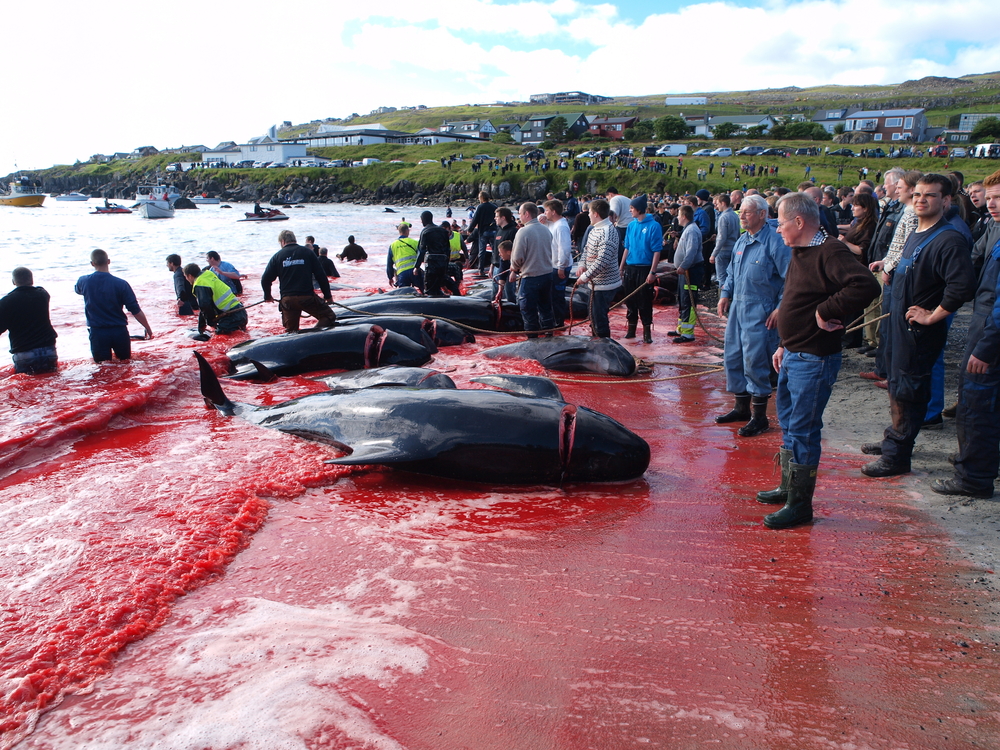Environment: Environmental Accords and Treaties
Environmental accords and treaties aim to regulate or manage human impact on the environment with the intention of protecting it. Humans impact the environment, often in negative ways. The effects of pollution are widespread and apparent, from trash along highways, to oil spills to fields of plastic waste in the ocean. Most environmental problems are not confined by borders but are global in scale, and thus they require the involvement of many countries to combat the problem. Though the environment is a broad category, these kinds of treaties usually have a specific focus, targeting ocean ecosystems or pollution and climate, for example, among other categories of concern. The treaties and accords are legally binding and governed by international law. However, despite worthy intentions, treaties and accords do not automatically bring about compliance.
The following is a list of France’s most important environmentally focused accords and treaties. Some have been ratified via France's membership in the United Nations, with its 193 member countries. Other treaties have been ratified through the European Union, which has 27 member countries, or through the Group of Seven (G7). The G7 is made up of Canada, France, Germany, Italy, Japan, the United Kingdom, and the United States, the world’s seven-largest advanced economies.
Antarctic Treaty
Entered into Force: December 1, 1959
Number of Signatories: 53
Objective: To ensure that Antarctica is used for peaceful purposes only (such as international cooperation in scientific research); to defer the question of territorial claims asserted by some nations and not recognized by others; to provide an international forum for management of the region; applies to land and ice shelves south of 60 degrees south latitude.
Basel Convention on the Control of Transboundary Movements of Hazardous Wastes and Their Disposal
Entered into Force: May 5, 1992
Number of Signatories: 187
Objective: To reduce transboundary movements of wastes subject to the Convention to a minimum consistent with the environmentally sound and efficient management of such wastes; to minimize the amount and toxicity of wastes generated and ensure their environmentally sound management as closely as possible to the source of generation; to assist LDCs in environmentally sound management of the hazardous and other wastes they generate.
Comprehensive Nuclear Test-Ban Treaty (CTBT)
Entered into Force: The CTBT will not formally enter into force until eight remaining "nuclear-capable states" sign and ratify the treaty; to date, China, Egypt, Iran, Israel, and the United States have signed but not ratified the treaty; India, North Korea, and Pakistan have not signed it.
Number of Signatories: 170
Objective: Bans all nuclear weapons test explosions, for both civilian and military purposes, in all environments.
Convention for the Conservation of Antarctic Seals
Entered into Force: March 11, 1978
Number of Signatories: 17
Objective: To promote and achieve the protection, scientific study, and rational use of Antarctic seals; to maintain a satisfactory balance within the ecological system of Antarctica.
Convention on Biological Diversity
Entered into Force: December 29, 1993
Number of Signatories: 195
Objective: To develop national strategies for the conservation and sustainable use of biological diversity and to address the fair and equitable sharing of benefits arising out of the utilization of genetic resources.
Convention on Fishing and Conservation of Living Resources of the High Seas
Entered into Force: March 20, 1966
Number of Signatories: 39
Objective: To solve through international cooperation the problems involved in the conservation of living resources of the high seas, taking into consideration the effects of modern technology, the world's population needs, and the dangers of over-exploitation.
Convention on Long-Range Transboundary Air Pollution
Entered into Force: 16 March 1983
Number of Signatories: 51
Objective: To protect the human environment against air pollution and, as far as possible, to gradually reduce and prevent air pollution, including long-range transboundary air pollution.
Convention on the Conservation of Antarctic Marine Living Resources
Entered into Force: April 7, 1982
Number of Signatories: 25 members, 11 acceding states
Objective: To safeguard the environment and protect the integrity of the ecosystem of the seas surrounding Antarctica, and to conserve Antarctic marine living resources.
Convention on the International Trade in Endangered Species of Wild Flora and Fauna (CITES)
Entered into Force: July 1, 1975
Number of Signatories: 183
Objective: To protect certain endangered species from overexploitation by means of a system of import/export permits.
Convention on the Prevention of Marine Pollution by Dumping of Wastes and Other Matter, 1972 (London Convention)
Entered into Force: August 30, 1975
Number of Signatories: 87
Objective: To promote effective control of all sources of marine pollution and to take all practicable steps to prevent pollution of the sea by dumping and to encourage regional agreements supplementary to the Convention.
Convention on the Prohibition of Military or Any Other Hostile Use of Environmental Modification Techniques
Entered into Force: October 5, 1978
Number of Signatories: 77
Objective: To prohibit the military or other hostile use of environmental modification techniques in order to further world peace and trust among nations.
Convention on Wetlands of International Importance Especially as Waterfowl Habitat (Ramsar)
Entered into Force: December 21, 1975
Number of Signatories: 170
Objective: To stem the progressive encroachment on and loss of wetlands now and in the future.
International Convention for the Regulation of Whaling
Entered into Force: November 10, 1948
Number of Signatories: 89
Objective: To protect all species of whales from overhunting; to establish a system of international regulation for the whale fisheries to ensure proper conservation and development of whale stocks; to safeguard for future generations the great natural resources represented by whale stocks.
International Tropical Timber Agreement, 2006
Entered into Force: December 7, 2011
Number of Signatories: 74
Objective: To promote the expansion and diversification of international trade in tropical timber from sustainably managed and legally harvested forests and to promote the sustainable management of tropical timber producing forests.
Kyoto Protocol to the United Nations Framework Convention on Climate Change
Entered into Force: February 16, 2005
Number of Signatories: 192
Objective: To further reduce greenhouse gas emissions by enhancing the national programs of developed countries aimed at this goal and by establishing percentage reduction targets for the developed countries.
Montreal Protocol on Substances That Deplete the Ozone Layer
Entered into Force: January 1, 1989
Number of Signatories: 197
Objective: To protect the ozone layer by controlling emissions of substances that deplete it.
Paris Agreement under the United Nations Framework Convention on Climate Change
Entered into Force: November 4, 2016
Number of Signatories: 190
Objective: To improve upon and replace the Kyoto Protocol, an earlier international treaty designed to curb the release of greenhouse gases that contribute to global warming; the Paris Agreement’s goal is to hold global average temperature increase to well below 2 degrees Celsius—preferably to 1.5 degrees Celsius—compared to pre-industrial levels and to achieve a climate neutral world by mid-century.
Note: Six years after signing the Paris Agreement, France was sued in 2021 by four environmental organizations for failing to meet the climate change goals it agreed to. In February of 2021, the Administrative Tribunal in Paris found that the country was guilty of “inaction” and had failed to meet the promises it agreed to by signing the Paris Agreement. No damages were awarded to the suing organizations, with the court ordering the French government to pay just one symbolic euro. Despite this, the head of Oxfam France called the ruling “a historic victory for climate justice.”
Protocol of 1978 Relating to the International Convention for the Prevention of Pollution From Ships, 1973 (MARPOL)
Entered into Force: October 2, 1983
Number of Signatories: 158
Objective: To preserve the marine environment in an attempt to completely eliminate pollution by oil and other harmful substances and to minimize accidental spillage of such substances.
Protocol on Environmental Protection to the Antarctic Treaty
Entered into Force: January 14, 1998
Number of Signatories: 41
Objective: To provide for comprehensive protection of the Antarctic environment and dependent and associated ecosystems; applies to the area covered by the Antarctic Treaty.
Protocol to the 1979 Convention on Long-Range Transboundary Air Pollution Concerning the Control of Emissions of Nitrogen Oxides or Their Transboundary Fluxes
Entered into Force: February 14, 1991
Number of Signatories: 35
Objective: To provide for the control or reduction of nitrogen oxide emissions and their transboundary fluxes.
Protocol to the 1979 Convention on Long-Range Transboundary Air Pollution Concerning the Control of Emissions of Volatile Organic Compounds or Their Transboundary Fluxes
Entered into Force: September 29, 1997
Number of Signatories: 24
Objective: To provide for the control and reduction of national emissions of volatile organic compounds in order to reduce their transboundary fluxes.
Protocol to the 1979 Convention on Long-Range Transboundary Air Pollution on Further Reduction of Sulphur Emissions
Entered into Force: August 5, 1998
Number of Signatories: 29
Objective: To provide for a further reduction in national sulfur emissions or transboundary fluxes on a regional basis within Europe.
Protocol to the 1979 Convention on Long-Range Transboundary Air Pollution on Heavy Metals
Entered into Force: December 29, 2003
Number of Signatories: 34
Objective: To reduce emissions of the heavy metals cadmium, lead, and mercury from industrial sources, combustion processes, and waste incineration.
Protocol to the 1979 Convention on Long-Range Transboundary Air Pollution on Persistent Organic Pollutants
Entered into Force: October 23, 2003
Number of Signatories: 34
Objective: To provide for the control, reduction, or elimination of discharges, emissions of persistent organic pollutants.
Protocol to the 1979 Convention on Long-Range Transboundary Air Pollution on the Reduction of Sulphur Emissions or Their Transboundary Fluxes by at Least 30 Percent
Entered into Force: September 2, 1987
Number of Signatories: 25
Objective: To provide for national reductions in sulfur emissions or transboundary fluxes by 30 percent of 1980 emission or transboundary flux levels by no later than 1993.
Protocol to the 1979 Convention on Long-Range Transboundary Air Pollution to Abate Acidification, Eutrophication, and Ground-Level Ozone
Entered into Force: May 17, 2005
Number of Signatories: 27
Objective: To reduce acidification, eutrophication, and ground-level ozone by setting emissions ceilings for sulphur dioxide, nitrogen oxides, volatile organic compounds, and ammonia.
Protocol to the Convention on the Prevention of Marine Pollution by Dumping of Wastes and Other Matter, 1972 (London Convention)
Entered into Force: March 24, 2006
Number of Signatories: 53
Objective: Prohibits all wastes for ocean disposal except those specifically identified; this "reverse list" ensures that the few materials that are permitted for ocean disposal are carefully evaluated and will not pose a danger to human health or the environment, and that there are not more feasible alternatives for their reuse or disposal.
Treaty Banning Nuclear Weapon Tests in the Atmosphere, in Outer Space, and Under Water
Entered into Force: October 10, 1963
Number of Signatories: 125
Objective: To ban nuclear weapons testing in the atmosphere, outer space, or under water.
United Nations Convention on the Law of the Sea (LOS)
Entered into Force: November 16, 1994
Number of Signatories: 167
Objective: To provide a comprehensive legal regime for the sea and oceans.
United Nations Convention to Combat Desertification in Those Countries Experiencing Serious Drought and/or Desertification, Particularly in Africa
Entered into Force: December 26, 1996
Number of Signatories: 196
Objective: To combat desertification and mitigate the effects of drought through an integrated framework that is consistent with Agenda 21, employing international cooperation and partnership arrangements, and effective action at all levels.
United Nations Framework Convention on Climate Change
Entered into Force: March 21, 1994
Number of Signatories: 196
Objective: To achieve stabilization of greenhouse gas concentrations in the atmosphere at a low enough level to prevent dangerous anthropogenic interference with the climate system.
Article written for World Trade Press by Felicia Topp; treaty data courtesy of CIA World Factbook.
Copyright © 1993—2024 World Trade Press. All rights reserved.

 France
France 
